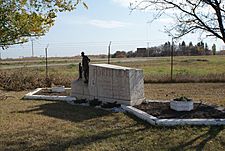Eaton Internment Camp facts for kids
Quick facts for kids Eaton Internment Camp |
|
|---|---|
| Internment camp | |

Memorial marker for the camp.
|
|
| Coordinates | 52°04′40″N 106°48′59″W / 52.07778°N 106.81639°W |
| Location | Saskatchewan, Canada |
| Operational | February 25 – March 21, 1919 |
The Eaton Internment Camp was a special kind of camp in Canada. It was one of 24 official places used to hold prisoners during World War I, which lasted from 1914 to 1920. Even though it was open for only a short time, it was the only camp like it in the province of Saskatchewan.
Contents
What Were Internment Camps?
During World War I, Canada was fighting against certain countries. People from those countries who lived in Canada were sometimes called "enemy aliens." This meant they were seen as foreigners from countries Canada was at war with.
A Special Law for Wartime
In 1914, Canada passed a law called the War Measures Act. This law gave the government special powers during wartime. Under this act, about 8,579 "enemy aliens" were held in Canada. Many of these people were immigrant settlers, especially those of Ukrainian background.
Why Were People Interned?
These people were sent to special camps, often in remote areas of Canada. They were treated as prisoners of war. Their job was to work on government projects, like building roads or railways. They were forced to do this work, almost like military labor.
Life in the Camps
As World War I came to an end, many of the people held in these camps were let go. This happened because there weren't enough workers in Canadian industries. Because of this, some camps were closed down. Others were combined, and some people were moved to different camps.
The Story of Eaton Camp
In October 1918, 65 people from one of these camps were sent to a facility in Munson, Alberta. There, they worked on the railway. However, a serious illness called the 1918 flu pandemic (also known as the Spanish Flu) spread, and there were some problems with rules among the people held there.
Moving to Eaton
Because of these issues, the Munson camp had to be moved. So, on February 25, 1919, the people were taken to a new camp. This camp was quickly built near a railway line at Eaton, Saskatchewan. It was hoped that this move would make the people happier, but it didn't really work.
A Short Stay
The people in the Eaton camp continued to resist. The military guards also didn't feel confident controlling the situation. So, the authorities decided to close the Eaton camp and move everyone to a more secure place. Just 24 days after it opened, on March 21, the people were sent by train to a military base in Amherst, Nova Scotia. There, they were processed to be sent back to their home countries. The Eaton Internment Camp was taken down soon after.
Remembering the Past
Today, the place where the Eaton camp once stood is part of the Saskatchewan Railway Museum. This museum is located near Saskatoon, where Highway 60 meets the Canadian National Railway.
The "Fortitude" Memorial
In 2005, a special monument was put up at the original camp site. This was part of a bigger effort across Canada to recognize and apologize for the internment of Ukrainians and others during World War I. The monument is called "Fortitude." It was created by Saskatchewan artist Grant McConnell.
The Prairie Centre for the Study of Ukrainian Heritage at the University of Saskatchewan worked with the Saskatchewan Railway Museum to create this bronze and stone memorial. It helps us remember this important part of Canadian history.


